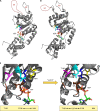The role of bacterial enhancer binding proteins as specialized activators of σ54-dependent transcription
- PMID: 22933558
- PMCID: PMC3429621
- DOI: 10.1128/MMBR.00006-12
The role of bacterial enhancer binding proteins as specialized activators of σ54-dependent transcription
Abstract
Bacterial enhancer binding proteins (bEBPs) are transcriptional activators that assemble as hexameric rings in their active forms and utilize ATP hydrolysis to remodel the conformation of RNA polymerase containing the alternative sigma factor σ(54). We present a comprehensive and detailed summary of recent advances in our understanding of how these specialized molecular machines function. The review is structured by introducing each of the three domains in turn: the central catalytic domain, the N-terminal regulatory domain, and the C-terminal DNA binding domain. The role of the central catalytic domain is presented with particular reference to (i) oligomerization, (ii) ATP hydrolysis, and (iii) the key GAFTGA motif that contacts σ(54) for remodeling. Each of these functions forms a potential target of the signal-sensing N-terminal regulatory domain, which can act either positively or negatively to control the activation of σ(54)-dependent transcription. Finally, we focus on the DNA binding function of the C-terminal domain and the enhancer sites to which it binds. Particular attention is paid to the importance of σ(54) to the bacterial cell and its unique role in regulating transcription.
Figures




















Similar articles
-
Nitric oxide-responsive interdomain regulation targets the σ54-interaction surface in the enhancer binding protein NorR.Mol Microbiol. 2010 Sep;77(5):1278-88. doi: 10.1111/j.1365-2958.2010.07290.x. Mol Microbiol. 2010. PMID: 20624215 Free PMC article.
-
Domain architectures of sigma54-dependent transcriptional activators.J Bacteriol. 2003 Mar;185(6):1757-67. doi: 10.1128/JB.185.6.1757-1767.2003. J Bacteriol. 2003. PMID: 12618438 Free PMC article. Review. No abstract available.
-
Bacterial enhancer-binding proteins: unlocking sigma54-dependent gene transcription.Curr Opin Struct Biol. 2007 Feb;17(1):110-6. doi: 10.1016/j.sbi.2006.11.002. Epub 2006 Dec 6. Curr Opin Struct Biol. 2007. PMID: 17157497 Review.
-
Repressor forms of the enhancer-binding protein NrtC: some fail in coupling ATP hydrolysis to open complex formation by sigma 54-holoenzyme.J Mol Biol. 1996 Jul 19;260(3):317-31. doi: 10.1006/jmbi.1996.0403. J Mol Biol. 1996. PMID: 8757796
-
A role for the conserved GAFTGA motif of AAA+ transcription activators in sensing promoter DNA conformation.J Biol Chem. 2007 Jan 12;282(2):1087-97. doi: 10.1074/jbc.M608715200. Epub 2006 Nov 6. J Biol Chem. 2007. PMID: 17090527
Cited by
-
Sigma factor RpoN (σ54) regulates pilE transcription in commensal Neisseria elongata.Mol Microbiol. 2013 Oct;90(1):103-13. doi: 10.1111/mmi.12350. Epub 2013 Aug 16. Mol Microbiol. 2013. PMID: 23899162 Free PMC article.
-
Transcriptional regulation of cellobiose utilization by PRD-domain containing Sigma54-dependent transcriptional activator (CelR) and catabolite control protein A (CcpA) in Bacillus thuringiensis.Front Microbiol. 2024 Jan 31;15:1160472. doi: 10.3389/fmicb.2024.1160472. eCollection 2024. Front Microbiol. 2024. PMID: 38357353 Free PMC article.
-
Structures of the P. aeruginosa FleQ-FleN master regulators reveal large-scale conformational switching in motility and biofilm control.Proc Natl Acad Sci U S A. 2023 Dec 12;120(50):e2312276120. doi: 10.1073/pnas.2312276120. Epub 2023 Dec 5. Proc Natl Acad Sci U S A. 2023. PMID: 38051770 Free PMC article.
-
Strain-Specific Gifsy-1 Prophage Genes Are Determinants for Expression of the RNA Repair Operon during the SOS Response in Salmonella enterica Serovar Typhimurium.J Bacteriol. 2023 Jan 26;205(1):e0026222. doi: 10.1128/jb.00262-22. Epub 2023 Jan 9. J Bacteriol. 2023. PMID: 36622230 Free PMC article.
-
Regulation of type VI secretion systems at the transcriptional, posttranscriptional and posttranslational level.Microbiology (Reading). 2023 Aug;169(8):001376. doi: 10.1099/mic.0.001376. Microbiology (Reading). 2023. PMID: 37552221 Free PMC article. Review.
References
Publication types
MeSH terms
Substances
Grants and funding
LinkOut - more resources
Full Text Sources
Other Literature Sources

